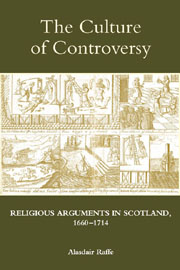Book contents
- Frontmatter
- Contents
- List of Maps and Illustrations
- Acknowledgements
- Abbreviations and Conventions
- Map 1 Scottish counties
- Map 2 Presbyteries, 1660–1714
- Introduction
- 1 The Culture of Controversy
- 2 Religious Groups and Cultures
- Part I Controversial Discourse
- Part II Controversial Action
- Conclusion: Concepts and Consequences
- Glossary
- Bibliography
- Index
- STUDIES IN MODERN BRITISH RELIGIOUS HISTORY
1 - The Culture of Controversy
from Introduction
Published online by Cambridge University Press: 05 February 2013
- Frontmatter
- Contents
- List of Maps and Illustrations
- Acknowledgements
- Abbreviations and Conventions
- Map 1 Scottish counties
- Map 2 Presbyteries, 1660–1714
- Introduction
- 1 The Culture of Controversy
- 2 Religious Groups and Cultures
- Part I Controversial Discourse
- Part II Controversial Action
- Conclusion: Concepts and Consequences
- Glossary
- Bibliography
- Index
- STUDIES IN MODERN BRITISH RELIGIOUS HISTORY
Summary
This book explores the religious arguments of late seventeenth- and early eighteenth- century Scotland. I have two principal aims. The first is to investigate the ‘culture of controversy’. Using this phrase, I seek to capture the ways in which Scots expressed their disagreements and argued about their collective problems. Religion was debated intensively across the period from 1660 to 1714, and it is an ideal focus for an interpretation of Scotland's controversial culture. But while I concentrate on religious discord, I hope to offer new perspectives on the processes and media of Scottish public life more generally. Whether they were discussing the constitution, the economy or religious diversity, Scots used a range of discursive practices and forms of communication. The book proposes a new approach to these public debates.
If the book's first aim is to assess the forms of controversial discourse, its second is to explain the substance of religious arguments between the Restoration and the death of Queen Anne. At root, the period's controversy resulted from the breakdown of religious uniformity in the wake of the ecclesiastical settlement of 1661–2, which restored bishops to the Church for the first time since the 1630s. In the revolution of 1688–90, the Restoration Church settlement was overturned, and presbyterianism was re-established. Most of the period's religious debates took place between supporters of the two forms of Church government – presbyterians and episcopalians – or between rivals within each group.
- Type
- Chapter
- Information
- The Culture of ControversyReligious Arguments in Scotland, 1660-1714, pp. 3 - 28Publisher: Boydell & BrewerPrint publication year: 2012



